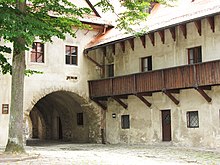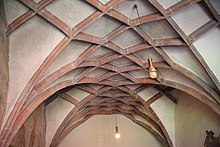Červený Kláštor (Monastery)
The Červený Kláštor ( Red Monastery ) is a former monastery at the mouth of the Lipník and the Dunajec in the Pienine Mountains , Slovakia . It is located at the western foot of the 657.4 m high and rugged monastery mountain ( Kláštorná hora ) in the municipality of the same name Červený Kláštor in Okres Kežmarok . Originally it was called Lechnica Monastery . The name Red Monastery is mostly traced back to the red roof. It also has brick masonry. From the outside today only the cornices made of shaped stones under the eaves of the church and the chapter house are visible. The window frames are made of stone . From the rest of the masonry, the plaster does not reveal which materials it was made of.
history
On the old trade route from Hungary to Poland, near a ford across the Dunajec, before its breakthrough through the Pienines, a hermitage was built, where the monastery was founded in 1320. As atonement for the murder of a provost of the Cross Lords of Šariš , Magister Kokos left the village of Lechnica in 1319 to the Carthusians of the Refuge Rocks (Skala útočišťa) to found a monastery. Karl I. Robert drew the deed of foundation in 1320, but construction of the monastery did not begin until 1330.
Carthusian Order
Its location on the border between Poland and Hungary as well as the trade connection from the Tisza to the Vistula brought the monastery wealth, since 1351 the monastery became independent. It had brewing, milling and fishing rights and jurisdiction. The Lechnica Monastery quickly developed into an important place of culture, science and spiritual life. In 1360 the small single-nave monastery church was built in the Gothic style. According to the rules of the Carthusian Order, the cells of the monks were made small. They were located in individual houses around a central cloister, on which the convent buildings and the church were also located. Magnificent codices were created in the Lechnica Monastery, two of which have survived. One of these illuminated parchment books is now in the Jagiellonian Library in Cracow , and another in the holdings of the Budapest University Library . The monks also devoted themselves to astronomy , medicine and alchemy .
When the Hussites from Poland invaded Slovakia ( Kingdom of Hungary ) under Dobeslav Puchala in 1431, after the pillage of Spišská Stará Ves, they also plundered the Lechnica monastery. In 1433 Hussite armies again invaded the Spiš under Johann Pardus von Hrádek and Friedrich von Strážnica ; The monastery was robbed again before their attack on Kežmarok .
Only a few years later it was the Bratríci of the Czech Petr Aksamits from whom the monastery suffered. The mercenary army ruled parts of the Spiš and became independent from 1454 into a band of robbers, whose captain Aksamit had his main camp in the rocks near the village of Haligovce, 3 km from the monastery . Only in 1462 could the Bratríci be driven out forever.
In 1462 the damage to the monastery was repaired, a refectory was created and the monastery property was expanded to include goods in the Zemplín wine-growing region . In 1507 the monastery acquired a thirtieth part of the rich city of Košice , as well as the jurisdiction over Veľká Lesná (Richwald).
This renewed heyday came to an end in 1526. The unrest in Royal Hungary (today's Slovakia) and the spread of the Reformation increasingly lead to the loss of its former status. An attack by Polish farmhands from Niedzica on the monastery causes more and more monks to leave the monastery out of fear for their safety. In 1563 the alchemist Martin Kacberborovic and his laboratory also fled the monastery to the safe Olomouc . Previously, he had initiated the Neudorf organist Andrej Smoczký into his art, who later portrayed it in the book Vade mecum et ego tecum .
After the abolition of the monastery in 1563, it was only inhabited by the previous prior. After his death in 1567 it was vacant and was administered by the provost of the Spis general chapter Gregor Bornemisza .
Privately owned
In 1569 Kaspar Magoczy acquired all of the monastery property, followed by Stephan Thököly and Georg Horvath. In 1626 the noble Rákóczi family became new owners. Under Paul Rákóczi repairs were carried out on the monastery buildings threatened with decay. In 1699 the Bishop of Neutra, Ladislav Maťašovský, acquired the monastery from Elisabeth Rákóczi . During the Rákóczi uprising , General Barthoty's army occupied the monastery in 1705, which the bishop had given to the Camaldolese in his will. 1709, the subject Kuruc back from Lechnica.
Camaldolese order
After the uprising ended, the Camaldolese took over the monastery in 1711. A renovation and a redesign in the baroque style took place. The monastery church was given a baroque tower in 1750 and a second farmyard and a chapel for travelers were added outside in 1754.
The new residents set up a brewery and an inn. Glass workshops were set up near Richwald, as well as agriculture, gardening and fishing. In 1754 a Camaldolese professorship was established in the monastery, which was moved to the Majk monastery in 1772 . Because of its location in a quiet environment and the mountain air, increasingly sick and old monks were accommodated in the monastery.
The monastery pharmacy, which was also founded in 1754, gained particular fame under Frater Cyprian (1724–1775), who ran it from 1756 until his death. Cyprian published the "Herbarium" in 1766 , which describes both a four-language description of 272 plant species of the Pienines and Tatras as well as various diseases and their cures. In addition, the brother also devoted himself to cosmology and mechanics.
In the 18th century, Father Romuald Hadbavný (1714–1780) worked as economic administrator and archivist of the monastery, who - especially in older research - as the author of the oldest surviving Slovak translation of the Bible, the so-called. Camaldolese Bible and a Latin-Slovak dictionary and translated songs by Louis de Blois into the Slovak language .
In 1782 the monasteries in Austria-Hungary were secularized under Joseph II.
After the dissolution
The monastery property was nationalized in 1782 and passed into the administration of the religious fund. The interior of the monastery was removed bit by bit. Some of the valuable items were sold, such as church furnishings that went to Muszyna , Poland . The monastery archive and library came to Pest .
With the establishment of the diocese Prešov (Eperies) of the Greek Catholic Church, Francis I left the monastery to him in 1820, but it was no longer used as such. In 1907 it was destroyed by fire.
In the 1920s, the Slovak Hiking and Ski Club became the new tenant of the facility and began to renovate two monks' houses and the facilities. Between 1956 and 1966, archaeological excavations were carried out in the monastery grounds and the subsequent reconstruction of the Red Monastery, which was declared a national cultural monument of Slovakia, in accordance with the preservation order. From 1992 to 1999 the interior of the church was renovated.
Today the monastery houses a museum and a restaurant.
See also
literature
- Beatrix F. Romhányi / Gábor Sarbak: Lechnic / Lechnitz , in: Monasticon Cartusiense , ed. by Gerhard Schlegel, James Hogg, Volume 2, Salzburg 2004, 70–76.
Web links
- The Red Monastery (Slovak. Červený Kláštor)
- The Red Monastery (Slovak. Červený Kláštor)
- Red Monastery - Červený Kláštor (German)
- THE KARTHAUS MONASTERY - ČERVENÝ KLÁŠTOR
- http://www.slovakheritage.org/Castles/cerveny_klastor.htm (English)
Coordinates: 49 ° 24 ′ 2 ″ N , 20 ° 24 ′ 59 ″ E



